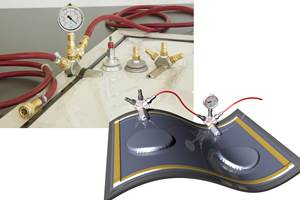Damage-propagation-resistant FRP: From bridge deck to canal lock
New work in application of composites in bridges and bridge decks.
“In the 1990s and early 2000s, infrastructure made using composites was the Holy Grail,” says FiberCore Europe (FCE, Rotterdam, Netherlands) founder Simon de Jong. A prime target was replace- ment of steel and concrete vehicular bridge decks with decks of composite construction. But in his company’s experience, the Grail remained out of reach, due to cracking, delamination and debonding. “The Achilles’ heel for fiber-reinforced plastics (FRP),” he explains, “has been durability under long-term, heavy loading after serious impact damage.”
FCE claims to have alleviated this issue via its patented InfraCore Inside technology, which has evolved beyond the conventional sandwich box beams between FRP faceskins used in vehicular decks to a design featuring multiple z-shaped, two-flanged web structures that are overlapped and then faced to form an extremely robust construction. “This is a much different approach vs. using pultruded or infused FRP elements and then joining them,” de Jong points out. “We have demonstrated that even with damage simulating impact from the edge of a steel shipping container, InfraCore Inside bridge structures can go on to sustain over 30 million load cycles from a real freight truck with no propagation of damage and the same strength and stiffness properties compared to pre-damage evaluation.” Testing completed at TU Delft (Delft, The Netherlands) and Chalmers University (Goteburg, Sweden) has shown InfraCore FRP bridge decks can perform in this manner for a single-axle load of 320 kN, two wheels per axle, with each wheel print measuring 0.35m by 0.6m.
A 142m bridge span over the A27 motorway near Utrecht features seven prefabricated InfraCore composite bridge deck segments joined and subsequently coupled to a steel support truss to achieve a EuroCode vehicle traffic load rating of 60 MT. The FRP deck weighs only 140 kg/m2 compared to 220 kg/m2 for a steel deck, resulting in an overall deck weight reduction of 72,000 kg.
The InfraCore deck sections were molded with accurate recesses for slotting connections, a water drainage gutter and integrated cable tray. Deck materials are dry, noncrimp E-glass fabrics and foam core. Notably, the latter acts as a mandrel and performs no structural function. The layups were infused with polyester resin per a design that orients fibers in multiple directions to provide a semi-plastic failure mode with redundant load paths that provided for residual load-bearing capacity.
Deck sections were transported to the bridge site by road, assembled with the steel truss supports and moved into place using self-propelled modular transporters. The underlying motorway was closed only for portions of two subsequent evenings, further reducing overall project cost. In the end, the InfraCore hybrid cost the same, upfront, as an all-steel solution, but offers longer service life, lower mainte- nance costs and fewer CO2 emissions during production.
This same technology has now enabled the world’s largest set of FRP canal lock gates. They measure 3m tall, 6m wide and bridge an overall 13m difference in water height, installed in the Wilhelminakanaal (Tilburg, The Netherlands). For the client Rijkswaterstaat, part of the Dutch Ministry of Infrastructure and the Environment (Utrecht, The Netherlands), FCE’s InfraCore Inside is no longer on trial but, instead, a proven technology: Contractor Heijmans (Rosmalen, Netherlands) installed eight FCE InfraCore FRP lock gates in 2015.
As a result of these successes, FCE has set its sights on reducing the budget for roughly 1 million bridges in the EU that need renovation. “We have engineered a renovation process with InfraCore that could save more than 10% of the estimated cost, or €7 billion,” says de Jong. As part of an EU project that also involves the US Army Corps of Engineers, FCE will complete engineering, testing and validation of the financial savings that might be possible over the coming two years.
Related Content
MFFD thermoplastic floor beams — OOA consolidation for next-gen TPC aerostructures
GKN Fokker and Mikrosam develop AFP for the Multifunctional Fuselage Demonstrator’s floor beams and OOA consolidation of 6-meter spars for TPC rudders, elevators and tails.
Read MoreSmartValves offer improvements over traditional vacuum bag ports
Developed to resolve tilting and close-off issues, SmartValves eliminate cutting through vacuum bags while offering reduced process time and maintenance.
Read MoreFrom the CW Archives: Airbus A400M cargo door
The inaugural CW From the Archives revisits Sara Black’s 2007 story on out-of-autoclave infusion used to fabricate the massive composite upper cargo door for the Airbus A400M military airlifter.
Read MorePEEK vs. PEKK vs. PAEK and continuous compression molding
Suppliers of thermoplastics and carbon fiber chime in regarding PEEK vs. PEKK, and now PAEK, as well as in-situ consolidation — the supply chain for thermoplastic tape composites continues to evolve.
Read MoreRead Next
VIDEO: High-rate composites production for aerospace
Westlake Epoxy’s process on display at CAMX 2024 reduces cycle time from hours to just 15 minutes.
Read More“Structured air” TPS safeguards composite structures
Powered by an 85% air/15% pure polyimide aerogel, Blueshift’s novel material system protects structures during transient thermal events from -200°C to beyond 2400°C for rockets, battery boxes and more.
Read MoreCFRP planing head: 50% less mass, 1.5 times faster rotation
Novel, modular design minimizes weight for high-precision cutting tools with faster production speeds.
Read More





















